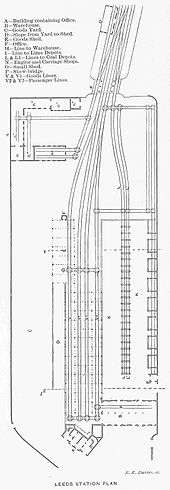Leeds Marsh Lane railway station
| Leeds Marsh Lane | |
|---|---|
| Location | |
| Place | Leeds |
| Area | City of Leeds |
| Coordinates | 53°47′48″N 1°31′45″W / 53.7967°N 1.5292°WCoordinates: 53°47′48″N 1°31′45″W / 53.7967°N 1.5292°W |
| Operations | |
| Original company | Leeds and Selby Railway |
| Pre-grouping | North Eastern Railway |
| Post-grouping | London and North Eastern Railway |
| History | |
| 22 September 1834 | Station opened |
| 9 November 1840 | Closed |
| November 1850 | Reopened |
| 1 April 1869 | Resited |
| 15 September 1958 | Closed |
| Disused railway stations in the United Kingdom | |
|
Closed railway stations in Britain A B C D–F G H–J K–L M–O P–R S T–V W–Z | |
|
| |
Marsh Lane railway station was built as the Leeds terminus of the Leeds and Selby Railway. The combined passenger and goods station opened in 1834.
During the construction of the extension of the Leeds and Selby Line into central Leeds in the 1860s the station was demolished, and replaced with a large goods station and a separate through passenger station.
History and description
Leeds and Selby station (1834-1863)

NB the diagram is schematic in that the walls of the main shed were not parallel.[note 1]
The station was built as the Leeds terminus of the Leeds and Selby Railway which opened in 1834.[1] The first official train to run on the line started from Marsh Lane at around 6.30 am on 22 September 1834.[2]
In 1842 the station consisted of a two story office building, containing a booking office on the ground floor, with the railway level with the first floor. The main station shed had four lines of track, serving both goods and passenger trains; the building was roofed and supported on cast iron columns.[note 1] The passenger lines lacked raised platforms, unlike other stations on the line.[5] Goods were handled at a warehouse at the west end of the station, adjacent to the offices, and at a supplementary building, added onto the northeast side of the original trainshed.[6]
The station also included the railway's workshops in the northeast corner of the site, and coal and lime depots on the south side.[7]
After the acquisition of the Leeds and Selby by the York and North Midland Railway (Y&NMR) in 1840 passenger trains were diverted via the Y&NMR's line to its station in Hunslet Lane station.[8] A local passenger service to Milford Junction was started in 1850.[9]
Post Leeds extension line (1863-)
Around 1863 the site at Marsh Lane was redeveloped into a goods station.[10] The old station was demolished and a six story grain warehouse was constructed on the site, designed by architect Thomas Prosser.[11] In 1869 the North Eastern Railway's (NER) Leeds extension line from Marsh Lane to Leeds New railway station was completed, allowing through running along the Leeds and Selby Line into Leeds and beyond.[12] A new passenger station was constructed at Marsh Lane on the route into central Leeds.[11]
In 1894 an expansion of the facilities at the station was completed.[13]
British Railways period
The station was closed in 1958.
The Prosser grain warehouse was burnt down by a fire in the 1970s.[11]
As of 2013 the site was being offered for redevelopment by London and Continental Railways.[14]
See also
- Leeds Central railway station and Holbeck railway station , also closed in the 1950/60s
Notes
References
- ↑ See Leeds and Selby Railway
- ↑ Tomlinson 1915, p. 256.
- ↑ Brees 1838, Plate 55.
- ↑ Ordnance Survey. Town plans 1:1056. 1850
- ↑ Whishaw 1842, p. 178.
- ↑ Fawcett 2001, pp.25, 26; fig.2.2, p.29.
- ↑ Whishaw 1842, pp. 178-9.
- ↑ Tomlinson 1915, pp. 341-2.
- ↑ Hoole 1986, p. 32.
- ↑ Tomlinson 1915, p. 651.
- 1 2 3 Fawcett 2001, p. 26.
- ↑ See Leeds and Selby Railway (NER period)
- ↑ Tomlinson 1915, p. 703.
- ↑ "Marsh Lane, Leeds", www.lcrhq.co.uk, retrieved 18 June 2014
Sources
- Whishaw, Francis (1842), The Railways of Great Britain and Ireland Practically Described and Illustrated (2nd ed.) , alt link
- Tomlinson, William Weaver (1915), The North Eastern Railway; its rise and development, Andrew Reid and Company, Newcastle; Longmans, Green and Company, London
- Brees, Samuel (1838), Railway practice (2nd ed.) , alt link , alt link
- Fawcett, Bill, ed. (2001), A History of North Eastern Railway Architecture, 1, North Eastern Railway Association
- Hoole, Ken (1986), A regional history of the railways of Great Britain. Vol 4, The North East (3rd ed.), David and Charles
External links
| Wikimedia Commons has media related to Marsh Lane railway station, Leeds. |
- "Leeds: Marsh Lane Station. 1961", www.flickr.com